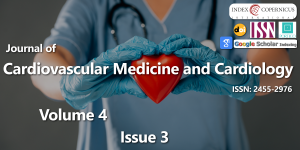Infective Endocardatis at the Yaounde General Hospital: Clinical aspects and outcome (Case Series)
Main Article Content
Abstract
Introduction: Infectious endocarditis (IE) is a severe pathology. Its epidemiological, clinical and evolutive profile varies a lot depending if it is in the context of a developed country or developing country. In our context, very little data exists on the subject.
Objectives: Describe the clinical aspects and outcome of IE in the Yaoundé general hospital.
Methods: We carried out a descriptive retrospective study using clinical records of patients who had presented with IE in the cardiology unit of the Yaoundé general hospital from June of 2008 to May of 2013.
Results: During this 5year period, 1846 patients were admitted in the cardiology unit and 10 of these cases were IE giving a hospital prevalence of 0.54%. The sex ratio was 1. The average age of the patients was 44.7 +/- 14.2 years. Rhumatismal valvulopathy was found as the most frequent predisposing factor, with 50% of the cases. The most frequent symptoms were fever and a heart murmur, which were found in 100% and 90% of the cases respectively. An inflammatory syndrome with anaemia was found in 90% of cases, leucocytosis with predominance of polymorphological neutrophils (PMN) in 80%, a raised ESR and CRP in all the patients. Hemocultures were positive only in 30% of the cases; however 60% of the patients had just one pair hemoculture done. Streptococcus was found in 2 cases and staphylococcus in 1 case. On echocardiography, vegetation and valvular regurgitation were found in all the patients. The antibiotherapy protocols were globally in conformity with recommendations and 40% of the patients completed their treatment. We found 4 deaths.
Conclusion: IE is a rare pathology in our unit. Rhumatismal valvulopathy is the principal predisposing factor. Its management is limited by technical conditions and economic difficulties.
Downloads
Article Details
Copyright (c) 2017 Boombhi J, et al.

This work is licensed under a Creative Commons Attribution 4.0 International License.
Devlin RK, Andrews MM, Van Reyn CF (2004) Recent trends in infective endocarditis: influence of case definitions. Curr Opin Cardiol 19: 134-139. Link: https://goo.gl/6ztHqA
Karth G, Koreny M, Binder T Knapp S, Zauner C, et al. (2002) Complicated infective endocarditis necessitating ICU admission: clinical course and prognosis. Crit Care 6: 149-154. Link: https://goo.gl/GYsVQP
Tleyjeh TM, Abdel-Latif A, Rahbi H Scott CG, Bailey KR, et al. (2007) A Systematic Review of Population-based study of Infective Endocarditis. Chest 132: 1025-1035. Link: https://goo.gl/5hPe1Y
Delahaye JP, Loire R, Delahaye F et al. (2000) Endocardite infectieuse. Encycl Méd Chir, Cardiologie 11-013-B-10, 25 p.
Habib G, Hoen B, Tornos P, et al. (2009) The Task Force on the Prevention, Diagnosis, and Treatment of Infective Endocarditis of the European Society of Cardiology. European Heart Journal 10: 1093-1185.
Koegelenberg CF, Doubell AF, Orth H, Reuter H (2003) Infective endocarditis in the Western Cape Province of South Africa: a three-year prospective study. QJM 96: 217-225. Link: https://goo.gl/m6oKt9
Math RS, Sharma G, Kothari SS Kalaivani M, Saxena A, et al. (2011) Prospective study of infective endocarditis from a developing country. Am Heart J 162: 633-638. Link: https://goo.gl/fNBgHL
Bruno Hoen, Xavier Duval (2013) Infective Endocarditis. N Engl J Med 368: 1425-1433. Link: https://goo.gl/WscENz
Rhys P Beynon, V K Bahl, Bernard D Prendergast (2006) Infective endocarditis. BMJ 333: 334-339. Link: https://goo.gl/aefqBy
Chao PJ, Hsu CH, Liu YC Sy CL, Chen, YS et al. (2009) Clinical and Molecular Epidemiology of Infective Endocarditis in Intravenous Drug Users. J Chin Med Assoc 72: 629-633. Link: https://goo.gl/fKdQer
Athan E, Chu VH, Tattevin P, et al. (2012) Clinical Characteristics and Outcome of Infective Endocarditis Involving Implantable Cardiac Devices. JAMA 307: 1727-1735. Link: https://goo.gl/7UrrQX
Vilacosta I, Sarria C, San Roman JA Jiménez J, Castillo JA, et al. (1994) Usefulness of transesophageal echocardiography for diagnosis of infected transvenous permanent pacemakers. Circulation 89: 2684-2687. Link: https://goo.gl/zzPrK5
Hoen B, Alla F, Selton-Suty C, Beguinot I, Bouvet A, et al. (2002) Changing profile of infective endocarditis: results of a 1-year survey in France. JAMA 288: 75-81. Link: https://goo.gl/sN6pBr
Thuny F, Di Salvo G, Belliard O, Avierinos JF, Pergola V, et al. (2005) Risk of embolism and death in infective endocarditis: prognostic value of echocardiography: a prospective multicenter study. Circulation 112: 69-75. Link: https://goo.gl/nz9jra
San Roman JA, Lopez J, Vilacosta I, Luaces M, Sarriá C, et al. (2007) Prognostic stratification of patients with left-sided endocarditis determined at admission. Am J Med 120: 369-376. Link: https://goo.gl/2iVuYw
Fedeli U, Schievano E, Buonfrate D, Pellizzer G, Spolaore P (2011) Increasing incidence and mortality of infective endocarditis: a population-based study through a record-linkage system. BMC Infect Dis 11: 48. Link: https://goo.gl/RL5NKA





